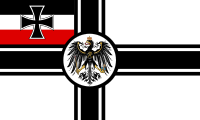
Back الجيش الإمبراطوري الألماني Arabic Exércitu Imperial Alemán AST Almaniya imperiyası ordusu Azerbaijani Германская імперская армія Byelorussian Германска имперска армия Bulgarian Exèrcit Imperial Alemany Catalan Německá císařská armáda Czech Det tyske kejserriges hær Danish Deutsches Heer (Deutsches Kaiserreich) German Germanimperia Armeo Esperanto
| German Army | |
|---|---|
| Deutsches Heer (German)[1] | |
 Standards of the Emperor | |
 | |
| Motto | Gott mit uns[5] |
| Founded | 16 April 1871[2] |
| Disbanded | 6 March 1919[3] |
| Service branches |
|
| Headquarters | Großes Hauptquartier (locations vary)[a] 52°31′12″N 13°22′12″E / 52.52000°N 13.37000°E |
| Leadership | |
| Commander-in-chief | German Emperor |
| Governing body | General Staff
|
| Chief of the General Staff | Moltke the Elder (first) Hans von Seeckt (last) |
| Personnel | |
| Military age | 17–45 |
| Conscription | 2–3 years; compulsory service |
| Reaching military age annually | |
| Active personnel | 14,250,000+ (total served; 1914–18)
<-- Engagements --> |
| Expenditure | |
| Budget | US$45 billion (total; 1914–18)[6] (US$1.3 trillion in 2022) |
| Related articles | |
| History | Germany during World War I |
| Ranks | Ranks of the Imperial German military |
The Imperial German Army (1871–1919), officially referred to as the German Army (German: Deutsches Heer[7]), was the unified ground and air force of the German Empire. It was established in 1871 with the political unification of Germany under the leadership of Prussia, and was dissolved in 1919, after the defeat of the German Empire in World War I (1914–1918). In the Federal Republic of Germany, the term Deutsches Heer refers to the German Army, the land component of the Bundeswehr.
- ^ "Militair-Strafgesetzbuch vom 20. Juni 1872" in Gesetz-Sammlung für das Deutsche Reich, 1867 bis 1883, incl. Vol. 1. Berlin, 1884. p. 408. Archived 2023-04-04 at the Wayback Machine (in German)
- ^ "documentArchiv.de – Verfassung des Deutschen Reichs". Archived from the original on 2019-10-17. Retrieved 2007-07-20.
- ^ Edmonds, James (1987). The Occupation of the Rhineland. London: HMSO. p. 213. ISBN 978-0-11-290454-0.
- ^ Grey, P. L.; Thetford, O. (1970) [1962]. German Aircraft of the First World War (2nd ed.). London: Putnam. p. 29. ISBN 978-0-370-00103-6.
- ^ Spector, Robert M. (2004). World Without Civilization: Mass Murder and the Holocaust, History and Analysis. Vol. I. University Press of America. p. 14. ISBN 978-0-7618-2963-8. Retrieved 20 May 2022.
- ^ H. E. Fisk (1924), The Inter-Allied Debts, pp. 13 & 325, reprinted in Horst Menderhausen (1943 edition), The Economics of War, appendix table II
- ^ "Militair-Strafgesetzbuch vom 20. Juni 1872" in Gesetz-Sammlung für das Deutsche Reich, 1867 bis 1883, incl. Vol. 1. Berlin, 1884. p. 408. Archived 2023-04-04 at the Wayback Machine (in German)
Cite error: There are <ref group=lower-alpha> tags or {{efn}} templates on this page, but the references will not show without a {{reflist|group=lower-alpha}} template or {{notelist}} template (see the help page).